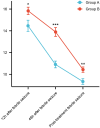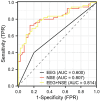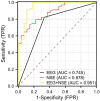Differential diagnostic value of electroencephalogram combined with NSE in pediatric febrile seizures and its predictive value for brain function prognosis
- PMID: 40225973
- PMCID: PMC11982893
- DOI: 10.62347/YMVM3188
Differential diagnostic value of electroencephalogram combined with NSE in pediatric febrile seizures and its predictive value for brain function prognosis
Abstract
Objective: To investigate the diagnostic value of electroencephalogram (EEG) combined with neuron-specific enolase (NSE) detection in differentiating febrile seizures and to evaluate their predictive value for brain function prognosis in pediatric patients.
Methods: A retrospective analysis was performed on the medical records of 95 pediatric patients with febrile seizures treated at the Second People's Hospital of Jingdezhen City from January 2021 to December 2023. Of these, 40 cases of simple febrile seizure (SFS) patients were categorized into Group A, and 55 cases of complex febrile seizure (CFS) patients were included in Group B. Brainwave data was collected within 72 hours of the seizure, and NSE levels were measured at 12 and 48 hours post-seizure, as well as immediately after treatment. Venous blood (1-2 mL) was drawn and tested within 2 hours. The number and incidence of abnormal EEG findings, along with NSE levels, were recorded. The diagnostic value of EEG, NSE, and their combined application in febrile seizures, as well as their predictive value for brain function prognosis, were analyzed.
Results: The incidence of abnormal EEG in Group B was notably higher than that in Group A (P=0.038). Additionally, the NSE level in Group B was consistently higher at all time points compared to Group A (all P<0.05). The area under the curve (AUC) for EEG, NSE, and their combined detection in differential diagnosis of febrile seizures was 0.600, 0.807, and 0.814, respectively. The specificity for these measures was 80.00%, 85.00%, and 75.00%, while the sensitivity was 40.00%, 72.73%, and 78.18%, respectively. The AUCs of EEG, NSE and their combined detection for predicting the prognosis of febrile seizures in children was 0.745, 0.878 and 0.951, with the specificity of 66.67%, 58.72% and 81.48%, and the sensitivity of 82.35%, 73.53% and 100.00%, respectively. Logistic multivariate analysis revealed that EEG findings, febrile seizure type, perinatal abnormalities, and NSE levels were independent risk factors affecting post-seizure sequelae in pediatric patients with febrile seizures.
Conclusion: The combination of EEG and NSE is valuable for the differential diagnosis of febrile seizures and offers strong predictive power for brain function prognosis. Their combined detection enhances diagnostic accuracy and offers substantial practical benefits.
Keywords: Electroencephalogram; febrile seizure; neuron-specific enolase.
AJTR Copyright © 2025.
Conflict of interest statement
None.
Figures




Similar articles
-
[Comparison of the accuracy of predicting prognosis of brain function in patients after cardiopulmonary cerebral resuscitation with two kinds of electroencephalogram techniques combined with neuron-specific enolase].Zhonghua Yi Xue Za Zhi. 2020 Jun 2;100(21):1629-1633. doi: 10.3760/cma.j.cn112137-20190911-02011. Zhonghua Yi Xue Za Zhi. 2020. PMID: 32486597 Chinese.
-
Detection and diagnostic value of serum NSE and S100B protein levels in patients with seizures associated with mild gastroenteritis: A retrospective observational study.Medicine (Baltimore). 2020 Nov 25;99(48):e23439. doi: 10.1097/MD.0000000000023439. Medicine (Baltimore). 2020. PMID: 33235129 Free PMC article.
-
Early postictal electroencephalography and correlation with clinical findings in children with febrile seizures.Korean J Pediatr. 2013 Dec;56(12):534-9. doi: 10.3345/kjp.2013.56.12.534. Epub 2013 Dec 20. Korean J Pediatr. 2013. PMID: 24416049 Free PMC article.
-
Risk factors for secondary epilepsy following febrile seizures in children: A meta-analysis.Epilepsy Behav. 2024 Dec;161:110051. doi: 10.1016/j.yebeh.2024.110051. Epub 2024 Sep 21. Epilepsy Behav. 2024. PMID: 39306980 Review.
-
Controversies in febrile seizures.Indian J Pediatr. 2000 Jan;67(1 Suppl):S71-9. Indian J Pediatr. 2000. PMID: 11129896 Review.
References
-
- Smith DK, Sadler KP, Benedum M. Febrile seizures: risks, evaluation, and prognosis. Am Fam Physician. 2019;99:445–450. - PubMed
-
- Hashimoto R, Suto M, Tsuji M, Sasaki H, Takehara K, Ishiguro A, Kubota M. Use of antipyretics for preventing febrile seizure recurrence in children: a systematic review and meta-analysis. Eur J Pediatr. 2021;180:987–997. - PubMed
-
- Paul SP, Rogers E, Wilkinson R, Paul B. Management of febrile convulsion in children. Emerg Nurse. 2015;23:18–25. - PubMed
-
- Mewasingh LD, Chin RFM, Scott RC. Current understanding of febrile seizures and their long-term outcomes. Dev Med Child Neurol. 2020;62:1245–1249. - PubMed
-
- Patel AD, Vidaurre J. Complex febrile seizures: a practical guide to evaluation and treatment. J Child Neurol. 2013;28:762–767. - PubMed
LinkOut - more resources
Full Text Sources
